At present, the number of payment alternatives in addition to physical money such as credit cards, payment with applications or mobile phones is increasing, and well-known coins and banknotes are gaining ground.
However, ElEconomist explains, there is evidence that, despite the apparent growth of other forms of payment, physical money continues to hold. According to the European Central Bank (ECB), almost half of all payments, 48%, are made using banknotes. In the US, the US Federal Reserve has noted that money in circulation has even reached an all-time high.
There are countries that are discussing this issue, and some countries are testing formulas for moving to a fully digital model. A Spanish website has compiled a list of cases where money could be on the brink of extinction.
Sweden:
Despite having the oldest central bank in the world, it has been leading the fight against physical money since the beginning of the last decade. Between 2011 and 2020, Swedish citizens reduced their use of cash from 39% to 9%. With companies, banks and other institutions refusing to accept payments in coins or banknotes, Sweden would be quite willing to move away from cash if rural areas didn’t resist its decline.
At the same time, the Swedish government is at the same time trying to slow down the transition by asking citizens to keep money at home.
Norway:
Norges Bank, the country’s central bank, has released figures that Norwegians only use banknotes or coins for 3 to 4% of their transactions, and the lack of physical liquidity in the country is a concern, so although they are about to achieve full digitization, they are trying to stop this is.
The Norwegian Consumer Protection Agency has already received complaints about the inability to pay for bus tickets or cafes in cash in the center of the capital, and the country’s Pensioners’ Association has also warned of the concerns this raises among a less digitized population.
Netherlands:
It is one of the countries not only in Europe but also in the world with the most development in this aspect, with a share of cash payments below 24% compared to 52% in 2005, 40% in 2011 and 30% in 2015. . . .
Data from the Dutch Payments Association shows that card usage for payments now exceeds 75%, with mobile payments up 30% last year.
In this case, banks are the biggest drivers of total digitalization to cut costs at branches and ATMs. In the Netherlands, 89% of customers are already digital, compared to the European average of 60%.
China:
The country is becoming so digitized in this regard that the People’s Bank of China is imposing fines on public and private institutions that refuse to accept cash payments in order to “protect citizens’ rights to use cash.”
The latest survey by the region’s central bank shows that 66% of payments in the region are made using a mobile phone, compared to 23% in cash. At the same time, the percentage of card payments is even less: only 7% of transactions.
South Korea:
Since 2016, the country has been trying to digitize payments, which is why cash in circulation is only 40% of the total, which is an all-time low. Of the total number of transactions in the country, only 17% are made in physical money.
Canada:
In the country led by Justin Trudeau, Visa said citizens are “ready to move away from cash” as Canada “has one of the highest penetration rates of credit card payments in the world (70%)”. As a percentage of total transactions in 2021, only 17% were made with physical money. Cards make up 60% of transactions and electronic payments 12%.
Australia:
The latest report from The Global Payments explains that the country is accelerating its transition to cash, which will account for just 2% of all transactions by 2025. From 75% in 2007 to around 30% in 2019.
















